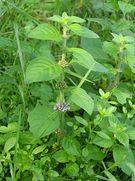MENTHA ARVENSIS
description & usage
Mint is native of the temperate Northern and Western Himalayas and Kashmir, cultivated in gardens in Konkan. It is growing in moist soil. Mint is aromatic herb and spices as well.
Uses:
Lowers body heat, cures spasms, jaundice, gallstone, vomiting, painful menstrual periods, diseases of the uterus, infection of the throat, toothache, increase the flow of milk in lactating mothers and emmenagogue.
How to Use:
A decoction or vapour of its tea is largely used with lemongrass as a febrifuge in fevers. It is also given in hiccup. Oil and menthol have the same properties. The latter is an invaluable anti-neuralgic applied externally in alcoholic solution or in the form of the popular "menthol cone". Mint tea helps to get rid of intestinal worm especially in children.
Parts Used:
Leaves
Taste:
Pungency, astringent
Action:
Aromatic, carminative, stimulant
Uses:
Lowers body heat, cures spasms, jaundice, gallstone, vomiting, painful menstrual periods, diseases of the uterus, infection of the throat, toothache, increase the flow of milk in lactating mothers and emmenagogue.
How to Use:
A decoction or vapour of its tea is largely used with lemongrass as a febrifuge in fevers. It is also given in hiccup. Oil and menthol have the same properties. The latter is an invaluable anti-neuralgic applied externally in alcoholic solution or in the form of the popular "menthol cone". Mint tea helps to get rid of intestinal worm especially in children.
Parts Used:
Leaves
Taste:
Pungency, astringent
Action:
Aromatic, carminative, stimulant


